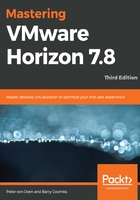
VMware Unified Access Gateway
The VMware Unified Gateway performs the same role as the view security server and is shown in the following diagram, but there's one key difference. Instead of being a Windows application and another role in the connection server, the Unified Access Gateway is a separate virtual appliance that runs a hardened, locked-down Linux operating system:

Although the Unified Gateway appliances deliver pretty much the same functionality as the security server, they do not yet completely replace it, especially if you already have a production deployment that uses the security server for external access. In that event, you can continue to use this architecture.
If you are using the secure tunnel function, PCoIP Secure Gateway, or the Blast Secure Gateway features of the connection server, then these features will need to be disabled on the connection server if you are using Unified Access Gateway. They are all enabled by default on the Unified Gateway appliance.
A key difference between Unified Access Gateway Appliances and the security server is in the way Unified Access Gateway scales. Before, you had to pair a security server with a connection server, which was a limitation, but this is no longer the case. As such, you can now scale to as many Unified Access Gateways as you need for your environment, with the maximum limit being around 2,000 sessions for a single appliance. Adding additional appliances is simply a case of deploying the appliance, as appliances don't depend on other appliances and do not communicate with them. They communicate directly with the connection servers over a load balancer.